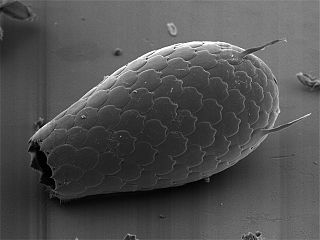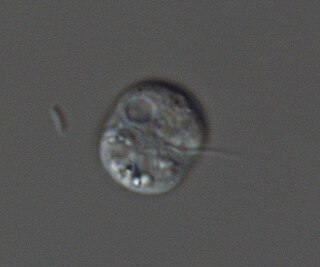
Cercozoa is a phylum of diverse single-celled eukaryotes. They lack shared morphological characteristics at the microscopic level, and are instead united by molecular phylogenies of rRNA and actin or polyubiquitin. They were the first major eukaryotic group to be recognized mainly through molecular phylogenies. They are the natural predators of many species of bacteria. They are closely related to the phylum Retaria, comprising amoeboids that usually have complex shells, and together form a supergroup called Rhizaria.

Cercomonads are small amoeboflagellates, widespread in aqueous habitats and common in soils.

Monadofilosa is a grouping of Cercozoa. These organisms are single-celled amoeboid protists.

Thecofilosea is a class of unicellular testate amoebae belonging to the phylum Cercozoa. They are amoeboflagellates, organisms with flagella and pseudopodia, distinguished from other cercozoa by their scale-lacking test composed of organic material. They are closely related to the Imbricatea, a group of testate amoebae with tests composed of inorganic silica scales.

The sarcomonads or class Sarcomonadea are a group of amoeboid biciliate protists in the phylum Cercozoa. They are characterized by a propensity to move through gliding on their posterior cilium or through filopodia, a lack of scales or external theca, a soft cell surface without obvious cortical filamentous or membranous skeleton, two cilia without scales or hairs, tubular mitochondrial cristae, near-spherical extrusomes, and a microbody attached to the nucleus.

Thaumatomastix is a protist genus of the order Thaumatomonadida, within the phylum Cercozoa and the class Imbricatea. Its species are aquatic, feeding on algae and appearing in waters of a wide range of temperatures and salinities, and are 15-50 micrometers long. They can interchange between flagellated and amoeboid forms, and are notable for being covered in both spiny and flattened siliceous scales.

Katabia is a genus of soil-dwelling heterotrophic flagellate cercozoans containing the single species Katabia gromovi, and the only member of family Katabiidae.

Neobodo are diverse protists belonging to the eukaryotic supergroup Excavata. They are Kinetoplastids in the subclass Bodonidae. They are small, free-living, heterotrophic flagellates with two flagella of unequal length used to create a propulsive current for feeding. As members of Kinetoplastids, they have an evident kinetoplast There was much confusion and debate within the class Kinetoplastid and subclass Bodonidae regarding the classification of the organism, but finally the new genera Neobodo was proposed by Keith Vickerman. Although they are one of the most common flagellates found in freshwater, they are also able to tolerate saltwater Their ability to alternate between both marine and freshwater environments in many parts of the world give them a “cosmopolitan” character. Due to their relatively microscopic size ranging between 4–12 microns, they are further distinguished as heterotrophic nanoflagellates. This small size ratio limits them as bacterivores that swim around feeding on bacteria attached to surfaces or in aggregates.
Neocercomonas is a protist genus of the order Cercomonadida. It consists of single-celled bacteriophagous organisms that usually live on or nearby terrestrial plants, both above and belowground. Species are biflagellate and may grow up to 60 micrometers long, with a trailing tail-like mass of protoplasm at their posterior end and a pair of roots connecting their posterior flagellum to the cytoskeleton.
The paracercomonads are a group of cercozoan protists. Taxonomically, they comprise the family Paracercomonadidae, order Paracercomonadida and subclass Paracercomonada. Due to their morphological similarities to the cercomonads, members of this family were grouped with Cercomonas and similar taxa from the beginning. However, their similarities are due to convergent evolution.

Ventrifilosa is a highly diverse group of phagotrophic protists that glide through their flagella and emit filose pseudopods from their ventral side for feeding. Because of their mixture of amoeba and flagellate characteristics, they are amoeboflagellates. Members of this group are the Imbricatea, Sarcomonadea and Thecofilosea.
Cryptofilida is an order of small heterotrophic protists in the phylum Cercozoa. They are filose amoebae that lack cilia and gliding, and are instead characterized by movement through branching or unbranched granular filopodia that are appressed to the substrate during their feeding.
Massisteriidae is a family of granofilosean protists within the phylum Cercozoa.

The glissomonads are a group of bacterivorous gliding flagellated protists that compose the order Glissomonadida, in the amoeboflagellate phylum Cercozoa. They comprise a vast, largely undescribed diversity of soil and freshwater organisms. They are the sister group to cercomonads; the two orders form a solid clade of gliding soil-dwelling flagellates called Pediglissa.
Pediglissa is a subclass of phagotrophic protists that inhabit soil or freshwater habitats. They were defined in 2018 according to phylogenetic analyses that showed a clade containing the orders Cercomonadida and Glissomonadida. They're the sister group of Paracercomonadida.

Viridiraptoridae, previously known as clade X, is a clade of heterotrophic protists in the phylum Cercozoa. They're a family of glissomonads, a group containing a vast, mostly undescribed diversity of soil and freshwater organisms.
Saccharomycomorpha is a genus of non-flagellated protists with a rare yeast-like appearance, containing the single species Saccharomycomorpha psychra. It is the only genus of the family Saccharomycomorphidae, within the cercozoan order Glissomonadida. Before its description in 2021 it was known as clade T, recovered from environmental DNA in previous phylogenetic analyses.

Rhogostoma minus is a species of thecate amoeba that belongs to the phylum Cercozoa. It was first described by Belar in 1921. These amoebae are heterotrophic, which means that they consume other organisms for nutrition. The cells of Rhogostoma minus are typically between 8 and 12 μm in diameter and are surrounded by a protective organic covering called a theca. The theca has a unique cleft-like opening that allows the amoebae to extend and retract thread-like projections called filose pseudopodia. The amoebae move along surfaces by pulling themselves forward using their pseudopodia.
Limnofila is a genus of heterotrophic protists that live in freshwater habitats and feed on bacteria. They are also present in the soil ecosystem, where they play an important role as predators of bacteria. They are classified as a single family Limnofilidae and order Limnofilida.

An amoeboflagellate is any eukaryotic organism capable of behaving as an amoeba and as a flagellate at some point during their life cycle. Amoeboflagellates present both pseudopodia and at least one flagellum, often simultaneously.








